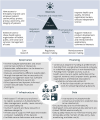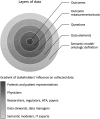Framework for Multistakeholder Patient Registries in the Field of Rare Diseases: Focus on Neurogenetic Diseases
- PMID: 39173102
- PMCID: PMC11379353
- DOI: 10.1212/WNL.0000000000209743
Framework for Multistakeholder Patient Registries in the Field of Rare Diseases: Focus on Neurogenetic Diseases
Abstract
Progress in genetic diagnosis and orphan drug legislation has opened doors to new therapies in rare neurogenetic diseases (RNDs). Innovative therapies such as gene therapy can improve patients' quality of life but come with academic, regulatory, and financial challenges. Registries can play a pivotal role in generating evidence to tackle these, but their development requires multidisciplinary knowledge and expertise. This study aims to develop a practical framework for creating and implementing patient registries addressing common challenges and maximizing their impact on care, research, drug development, and regulatory decision making with a focus on RNDs. A comprehensive 3-step literature and qualitative research approach was used to develop the framework. A qualitative systematic literature review was conducted, extracting guidance and practices leading to the draft framework. Subsequently, we interviewed representatives of 5 established international RND registries to add learnings from hands-on experiences to the framework. Expert input on the draft framework was sought in digital multistakeholder focus groups to refine the framework. The literature search; interviews with 5 registries; and focus groups with patient representatives (n = 4), clinicians (n = 6), regulators, health technology assessment (HTA) bodies and payers (n = 7), industry representatives (n = 7), and data/information technology (IT) specialists (n = 5) informed development of the framework. It covers the interests of different stakeholders, purposes for data utilization, data aspects, IT infrastructure, governance, and financing of rare disease registries. Key principles include that data should be rapidly accessible, independent, and trustworthy. Governance should involve multiple stakeholders. In addition, data should be highly descriptive, machine-readable, and accessible through a shared infrastructure and not spread over multiple isolated repositories. Sustainable and independent financing of registries is deemed important but remains challenging because of a lack of widely supported funding models. The proposed framework will guide stakeholders in establishing or improving rare disease registries that fulfill requirements of academics and patients as well as regulators, HTA bodies, and commercial parties. There is a need for more clarity regarding quality requirements for registries in regulatory and HTA context. In addition, independent financing models for registries should be developed, as well as well-defined policies on technical uniformity in health data.
Conflict of interest statement
D.H. Schoenmakers, M. Datema, and N.I. Wolf are members of the MLD initiative, which is an academic registry and collaborative platform for metachromatic leukodystrophy. The MLD initiative was a case study at the program “Managing patient registries for expensive drugs” and received funding from the Dutch Healthcare Institute between April 2021 and March 2023. D.H. Schoenmakers, S. van den Berg, N. Rosenberg, and C.E.M. Hollak are members of platform “Medicijn voor de Maatschappij.” This is an academic initiative that aims to support sustainable access to medicines for rare diseases. This platform is financially supported by a grant from “de Nationale Postcode Loterij,” a National Lottery that distributes funds raised by this lottery for good causes primarily concerning health and welfare in the Netherlands. L. Adang is consultant and/or coinvestigator for clinical trials in Metachromatic Leukodystrophy and other leukodystrophies (Shire/Takeda, Orchard, Ionis, Lilly). T. Bäumer received funding from the German Research Foundation (DFG, BA 6375/2-1), received speaker and consultant fees from Pelzerhaken Children's Centre, Allergan/Abbvie, Ipsen Pharma and Merz Therapeutics, and received research funding from Allergan/Abbvie, Ipsen Pharma, and Merz Therapeutics. H. Graessner is coordinator of the European Reference Network for Rare Neurological Diseases that receives funding from the European Union. G. Höglinger has ongoing research collaborations with Roche, UCB, and Abbvie, serves as a consultant for Abbvie, Alzprotect, Amylyx, Aprineua, Asceneuron, Bayer, Bial, Biogen, Biohaven, Epidarex, Ferrer, Kyowa Kirin, Lundbeck, Novartis, Retrotope, Roche, Sanofi, Servier, Takeda, Teva, and UCB, received honoraria for scientific presentations from Abbvie, Bayer, Bial, Biogen, Bristol Myers Squibb, Kyowa Kirin, Pfizer, Roche, Teva, UCB, and Zambon, holds a patent on Treatment of Synucleinopathies (US 10,918,628 B2, EP 17 787 904.6-1109/3 525 788), and received publication royalties from Academic Press, Kohlhammer, and Thieme. H. van den Hout received funding for research, clinical trials, and advisory fees from Sanofi, Denali Therapeutics, Amicus Therapeutics, Chiesi, and Takeda working on enzyme replacement therapy or next generation therapies in the field of lysosomal storage diseases or neuromuscular disorders, under agreements with Erasmus MC University Medical Center and the relevant industry. M. Langeveld is involved in premarketing studies with Sanofi-Genzyme, Protalix/Chiesi, and Idorsia. Financial arrangements were made through AMC Research BV. No fees, travel support or grants were obtained from Pharmaceutical Industry. T. Klockgether is receiving research support from the Bundesministerium für Bildung und Forschung (BMBF), the NIH, and Servier, and received consulting fees from UCB and Vico Therapeutics within the last 24 months. M.S. van der Knaap is a consultant for Calico (Vanishing White Matter) and a coinvestigator for Ionis (Alexander disease trial) without personal payment, is on patents P112686US00 “therapeutic effects of Guanabenz treatment in vanishing white matter” and P112686CA00 “the use of Guanabenz in the treatment of VWM,” both for the VU University Medical Center, Amsterdam, the Netherlands, and is the initiator and principal investigator of the Guanabenz trial (
Figures



References
MeSH terms
LinkOut - more resources
Full Text Sources
Medical
